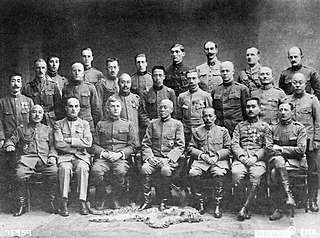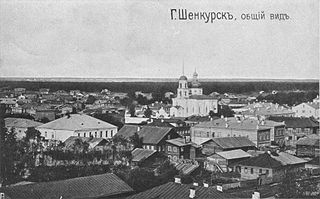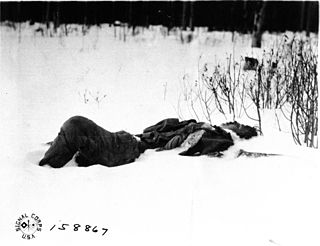
The Russian Civil War was a multi-party civil war in the former Russian Empire sparked by the overthrowing of the social-democratic Russian Provisional Government in the October Revolution, as many factions vied to determine Russia's political future. It resulted in the formation of the Russian Socialist Federative Soviet Republic and later the Soviet Union in most of its territory. Its finale marked the end of the Russian Revolution, which was one of the key events of the 20th century.

The Battle of Austerlitz, also known as the Battle of the Three Emperors, was one of the most important military engagements of the Napoleonic Wars. The battle occurred near the town of Austerlitz in the Austrian Empire. Around 158,000 troops were involved, of which around 24,000 were killed or wounded. The battle is often cited by military historians as one of Napoleon's tactical masterpieces, in the same league as other historic engagements like Cannae or Gaugamela. The military victory of Napoleon's Grande Armée at Austerlitz brought the War of the Third Coalition to an end, with the Peace of Pressburg signed by the French and Austrians later in the month. These achievements did not establish a lasting peace on the continent. Austerlitz had driven neither Russia nor Britain, whose armies protected Sicily from a French invasion, to settle. Prussian resistance to the growing power of French military invasions in Central Europe led to the War of the Fourth Coalition in 1806.

The Battle of Leipzig, also known as the Battle of the Nations, was fought from 16 to 19 October 1813 at Leipzig, Saxony. The Coalition armies of Austria, Prussia, Sweden, and Russia, led by Tsar Alexander I and Karl von Schwarzenberg, decisively defeated the Grande Armée of French Emperor Napoleon Bonaparte. Napoleon's army also contained Polish and Italian troops, as well as Germans from the Confederation of the Rhine. The battle was the culmination of the German Campaign of 1813 and involved 560,000 soldiers, 2,200 artillery pieces, the expenditure of 400,000 rounds of artillery ammunition, and 133,000 casualties, making it the largest battle of the Napoleonic Wars, and the largest battle in Europe prior to World War I.

The Second Battle of the Marne was the last major German offensive on the Western Front during the First World War. The attack failed when an Allied counterattack, led by French forces and supported by several hundreds of Renault FT tanks, overwhelmed the Germans on their right flank, inflicting severe casualties. The German defeat marked the start of the relentless Allied advance which culminated in the Armistice with Germany about 100 days later.

The Allied intervention in the Russian Civil War consisted of a series of multi-national military expeditions that began in 1918. The initial impetus behind the interventions was to secure munitions and supply depots from falling into the German Empire's hands, particularly after the Bolsheviks signed the Treaty of Brest-Litovsk, and to rescue the Allied forces that had become trapped within Russia after the 1917 October Revolution. After the Armistice of 11 November 1918, the Allied plan changed to helping the White forces in the Russian Civil War. After the Whites collapsed, the Allies withdrew their forces from Russia by 1925.

The North Russia intervention, also known as the Northern Russian expedition, the Archangel campaign, and the Murman deployment, was part of the Allied intervention in the Russian Civil War after the October Revolution. The intervention brought about the involvement of foreign troops in the Russian Civil War on the side of the White movement. The movement was ultimately defeated, while the British-led Allied forces withdrew from Northern Russia after fighting a number of defensive actions against the Bolsheviks, such as the Battle of Bolshie Ozerki. The campaign lasted from March 1918, during the final months of World War I, to October 1919.

The Battle of Mărășești was the last major battle fought by the Central Powers against the Kingdom of Romania and Russia on the Romanian front during World War I. Romania was mostly occupied by the Central Powers, but the Battle of Mărășești kept the northern region of the country free from occupation.

The United States campaigns in World War I began after American entry in the war in early April 1917. The American Expeditionary Force (AEF) served on the Western Front, under General John J. Pershing, and engaged in 13 official military campaigns between 1917 and 1918, for which campaign streamers were designated. The streamer uses the colors of the World War I Victory Medal ribbon which had a red center with a rainbow on each side of the center stripe and a purple edge. The double rainbow symbolizes the dawn of a new era and the calm which follows the storm.

The Western Allied invasion of Germany was coordinated by the Western Allies during the final months of hostilities in the European theatre of World War II. In preparation for the Allied invasion of Germany east of the Rhine, a series of offensive operations were designed to seize and capture its east and west banks: Operation Veritable and Operation Grenade in February 1945, and Operation Lumberjack and Operation Undertone in March 1945; these are considered separate from the main invasion operation. The Allied invasion of Germany east of the Rhine started with the Western Allies crossing the river on 22 March 1945 before fanning out and overrunning all of western Germany from the Baltic in the north to the Alpine passes in the south, where they linked up with troops of the U.S. Fifth Army in Italy. Combined with the capture of Berchtesgaden, any hope of Nazi leadership continuing to wage war from a so-called "national redoubt" or escape through the Alps was crushed, shortly followed by unconditional German surrender on 8 May 1945. This is known as the Central Europe Campaign in United States military histories.

The Siberian intervention or Siberian expedition of 1918–1922 was the dispatch of troops of the Entente powers to the Russian Maritime Provinces as part of a larger effort by the western powers, Japan, and China to support White Russian forces and the Czechoslovak Legion against Soviet Russia and its allies during the Russian Civil War. The Imperial Japanese Army continued to occupy Russian cities of Eastern Siberia, even after other Allied forces withdrew in 1920.

The Battle of Hollandia was an engagement between Allies of World War II and Japanese forces during World War II. The majority of the Allied force was provided by the United States, with the bulk of two United States Army infantry divisions being committed on the ground. Air and naval support consisted largely of U.S. assets, although Australia also provided air support during preliminary operations and a naval bombardment force.

The Aragon Offensive was an important military campaign during the Spanish Civil War, which began after the Battle of Teruel. The offensive, which ran from March 7, 1938, to April 19, 1938, smashed the Republican forces, overran Aragon, and conquered parts of Catalonia and the Levante.
The Battle of Tulgas was part of the North Russia Intervention into the Russian Civil War and was fought between Allied and Bolshevik troops on the Northern Dvina River 200 miles south of Arkhangelsk. It took place on the day the armistice ending World War I was signed, November 11, 1918, and is sometimes referred to as "The Battle of Armistice Day." Shortly before the battle, the freezing of the local waterways resulted in the cutting off of the Tulgas Garrison from outside assistance, and the freezing of the ground let the Bolsheviks move troops to surround Tulgas. The Bolsheviks used this opportunity and their superior numbers to try to attack and conquer the isolated outpost, but were driven back with severe losses.

The Russian Civil War (1917–1921) began after the provisional government collapsed and the Bolshevik party assumed power in October 1917. The principal fighting occurred between the Bolshevik Red Army and the forces of the White Army, a group of loosely allied anti-Bolshevik forces. During the war several foreign armies took part, mostly fighting against the Red Army—including the Western allies—and many foreign volunteers fought for both sides. Other nationalist and regional political groups also participated in the war, including the Ukrainian nationalist Green Army, the Ukrainian anarchist Insurgent Army and Black Guards, and warlords such as Ungern von Sternberg. Despite some pressure from Britain, the Australian Prime Minister, William Hughes, had refused to commit forces to Russia following the end of World War I in 1918.

The Battle of Shenkursk, in January 1919, was a major battle of the Russian Civil War. Following the Bolshevik loss at the Battle of Tulgas, the Red Army's next offensive action was against the Allied garrison of Shenkursk; located on the Vaga River. Allied forces in Shenkursk and the surrounding villages included men primarily from the United States and the United Kingdom with support from the White Russians. The battle ended with an Allied retreat from Shenkursk ahead of a superior Bolshevik army.

The Battle of Romanovka was fought in June 1919 during the Russian Civil War. Russian Bolsheviks of Yakov Tryapitsyn launched a surprise attack on an American army camp at Romanovka, near Vladivostok. As a result of the engagement, the attacks were repelled. Romanovka and the Suchan Valley Campaign that followed were the final major engagements of the Russian Civil War involving the United States. Battles would later break out again between the Americans and Soviets, as well as the Cossacks, on much smaller scales. Likewise, the Americans were invariably victorious.

The following events occurred in January 1919:

The Battle of Bolshie Ozerki was a major engagement fought during the Allied North Russia Intervention in the Russian Civil War. Beginning on March 31, 1919, a force of British, American, Polish, and White Russian troops engaged several Red Army partisan regiments at the village of Bolshie Ozerki. Although the initial Allied attacks were repelled, the outnumbered Allies managed to repel the Soviet flanking attempts that followed and the Red Army was later ordered to withdraw. Allied forces began to withdraw rapidly from northern Russia shortly thereafter.

The siege of Perekop, also known as the Perekop-Chongar Operation, was a battle of the Southern Front in the Russian Civil War from 7 to 17 November 1920. The White movement's stronghold on the Crimean Peninsula was protected by the Chongar fortification system along the strategic Isthmus of Perekop and the Syvash, from which the Crimean Corps under General Yakov Slashchov repelled several Red Army invasion attempts in early 1920. The Southern Front of the Red Army and the Revolutionary Insurgent Army of Ukraine, under the joint command of Mikhail Frunze, launched an offensive on Crimea with an invasion force four-times larger than the defenders, the White Russian Army under the command of General Pyotr Wrangel. Despite suffering heavy losses, the Reds broke through the fortifications, and the Whites were forced into retreat southwards. Following their defeat at the siege of Perekop, the Whites evacuated from the Crimea, dissolving the Army of Wrangel and ending the Southern Front in Bolshevik victory.

The 1917 Romanian Campaign consisted in three battles between late July and early September 1917, fought between Germany and Austria-Hungary on one side versus Romania and Russia on the other. Romania emerged from this campaign with a slight net territorial gain and won its most important battle during the First World War.


















